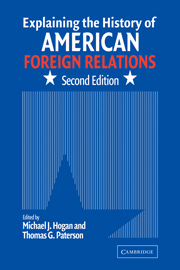Book contents
- Frontmatter
- Contents
- Preface to the Second Edition
- Contributors
- 1 Introduction
- 2 Defining and Doing the History of United States Foreign Relations : A Primer
- 3 Toward a Pluralist Vision : The Study of American Foreign Relations as International History and National History
- 4 Theories of International Relations
- 5 Bureaucratic Politics
- 6 Psychology
- 7 National Security
- 8 Corporatism
- 9 World Systems
- 10 Dependency
- 11 Considering Borders
- 12 The Global Frontier : Comparative History and the Frontier-Borderlands Approach
- 13 Modernization Theory
- 14 Ideology
- 15 Culture and International History
- 16 Cultural Transfer
- 17 Reading for Meaning : Theory, Language, and Metaphor
- 18 What's Gender Got to Do with It? Gender History as Foreign Relations History
- 19 Race to Insight: The United States and the World, White Supremacy and Foreign Affairs
- 20 Memory and Understanding U.S. Foreign Relations
- Index
3 - Toward a Pluralist Vision : The Study of American Foreign Relations as International History and National History
Published online by Cambridge University Press: 05 June 2012
- Frontmatter
- Contents
- Preface to the Second Edition
- Contributors
- 1 Introduction
- 2 Defining and Doing the History of United States Foreign Relations : A Primer
- 3 Toward a Pluralist Vision : The Study of American Foreign Relations as International History and National History
- 4 Theories of International Relations
- 5 Bureaucratic Politics
- 6 Psychology
- 7 National Security
- 8 Corporatism
- 9 World Systems
- 10 Dependency
- 11 Considering Borders
- 12 The Global Frontier : Comparative History and the Frontier-Borderlands Approach
- 13 Modernization Theory
- 14 Ideology
- 15 Culture and International History
- 16 Cultural Transfer
- 17 Reading for Meaning : Theory, Language, and Metaphor
- 18 What's Gender Got to Do with It? Gender History as Foreign Relations History
- 19 Race to Insight: The United States and the World, White Supremacy and Foreign Affairs
- 20 Memory and Understanding U.S. Foreign Relations
- Index
Summary
So many signs of robust health abound that one might speak without too much exaggeration of an emergent renaissance in the study of U.S. diplomatic history. For close to a decade now, annual meetings of the Society for Historians of American Foreign Relations (SHAFR) have attracted between 300 and 400 participants, extraordinary figures for any subdiscipline. Those meetings, moreover, have included a growing contingent of scholars from outside the United States, offering unmistakable evidence of the burgeoning internationalization of the study of U.S. foreign relations. SHAFR now boasts close to 1,700 members, over 300 of whom are non-Americans. Diplomatic History, the society's flagship journal, remains not just vibrant in terms of the quality and diversity of its essays, reviews, forums, and think pieces, but highly innovative as well, regularly showcasing work that pushes the traditional boundaries of the field in challenging new directions. And Diplomatic History finds itself competing for article submissions with the growing number of rival journals also devoted principally to scholarship on the history of international relations: International History Review (established in 1978), the Journal of American-East Asian Relations (1992), the Journal of Cold War Studies (1999), and Cold War History (2000) chief among them.
University and commercial publishers continue actively to solicit manuscripts on U.S. diplomatic history, some of which even manage to attract enthusiastic readerships outside academe.
- Type
- Chapter
- Information
- Explaining the History of American Foreign Relations , pp. 35 - 50Publisher: Cambridge University PressPrint publication year: 2004
- 2
- Cited by



